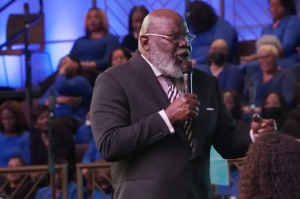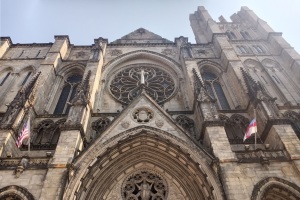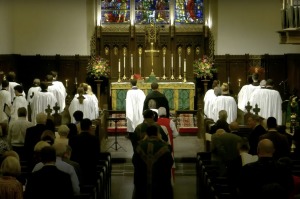'Building the Old Time Religion' Explores Women Evangelists' Monumental Impact on US Christianity
Author Examines Amanda Berry Smith, Evangeline Booth, Helen Sunday, Aimee Semple McPherson, and Others
 2 photos(Photo: NYU Press)Building the Old Time Religion: Women Evangelists in the Progressive Era (Dec. 2013, NYU Press), by Priscilla Pope-Levison.
2 photos(Photo: NYU Press)Building the Old Time Religion: Women Evangelists in the Progressive Era (Dec. 2013, NYU Press), by Priscilla Pope-Levison.These women were Methodist, Roman Catholic, Presbyterian, Pentecostal, and some of them founded their own denominations. They also gave America some of her oldest and most influential ministries, organizations and educational institutions. Yet, their names and contributions to U.S. Christianity are overshadowed by the names and legacies of their male counterparts.
For theologian Priscilla Pope-Levison, the 24 women evangelists featured in her new book, Building the Old Time Religion, are the "unsung heroines" of the Christian faith in America.
Pope-Levison, professor of Theology at Seattle Pacific University, has been fascinated with the history of Christian women for decades. The theologian, author and ordained United Methodist minister shares her discoveries unearthed over the last 20 years through painstaking research in Building the Old Time Religion: Women Evangelists in the Progressive Era (NYU Press).
Building the Old Time features in-depth accounts of the lives, accomplishments and controversies of influential Christian leaders such as Amanda Berry Smith, Evangeline Booth, Helen Sunday, Aimee Semple McPherson, Jennie Fowler Willing, Martha Lee, Anna Prosser, Minnie Draper and numerous others (read some of their profiles here).
Below is a transcript of CP's interview with Pope-Levison about her new book, the tensions surrounding women in leadership and how she came to focus on just 24 women. The transcript has been edited for clarity.
CP: I know the bulk of your work is related to women, but what motivated you to pursue this particular area of women evangelists?
Pope-Levison: Well it began about 20 some years ago when I was teaching evangelism at Duke Divinity School and I was putting together an introductory lecture on the history of evangelism in the United States. What I could find were stacks of resources on particularly male evangelists, the great male evangelists beginning with Jonathan Edwards going through Charles Finney to Dwight Moody, all the way to Billy Graham.
Being a woman minister myself and interested in women's religious leadership, I asked myself the question, 'Were there any women evangelists beyond Kathryn Kuhlman and Aimee Semple Mcpherson?' So that really started my research into an amazing amount of material and I feel like in some ways I've only scratched the surface after 20 years of research on an enormous amount of women who call themselves evangelists and traveled around the country. This book argues the thesis that they settled down and built institutions during the Progressive Era in our country, which was 1890 to 1920.
CP: Was this era particularly ripe for this type of movement?
Pope-Levison: Women's issues are really coming to the fore [during this era]. People locate [here] what they call the first wave of feminism beginning around 1880/1890, and so there was a lot more, particularly with the women's suffrage movement, attention being given to women's issues, women in general, along with the founding of the Women's Christian Temperance Union which was the largest women's organization in the country in the late 19th and early 20th century.
So there's a lot of attention on women and women are beginning to enter the workforce in greater numbers, and this is pressing on the Church as well. So the question of women's ordination is already coming up, for instance in my denomination, in the Methodist Episcopal Church. This is coming up in the 1880s and on. It never dies away until women are ordained in the fifties. I think the second thing that's coming to the fore is there's a strong belief in the people to change society and so you have things like the push for an income tax and the push for kindergarten and playgrounds, and there's a lot of momentum and movement for reform in the Progressive Era.
Women seize this opportunity to begin to plant their own churches, to found their own religious training schools to reach out to the poor and the homeless through rescue homes and rescue missions, and prostitutes and so forth. There's just a lot of movement and momentum for change and reform at is time that women evangelists take advantage of. There's also a lot of institution building. This was an incredible time of building colleges and beginning hospitals and so forth, so they take advantage of this time in our country.
CP: Was this a natural progression for these women evangelists then, they sort of simply moved with the times?
Pope-Levison: Yes and no. My book argues that up until this time women evangelists have been itinerating. They've been traveling around pretty much on their own from place to place wherever they were invited to preach the Gospel because there's still a lot of animosity toward women in the public religious space, which continues today.
Particularly back in the late 19th century, a woman preacher, a woman evangelist was an oddity, was a curiosity and there's also a lot of animosity about them. It is a change in strategy for these women to settle down and build institutions. Whether that's a natural evolution, I'm not sure that I could say, but it does tap into what's going on in the country at the time.
The other reality is that these women didn't have churches that were accepting them. With the exception of the Quakers and Congregational Churches, there weren't churches that were ordaining these women, so in some ways they were forced to found their own institutions in order to have access to religious leadership. That's why I wouldn't argue that it's completely a natural evolution. They're also taking a stand and making room for themselves by building their own institutions.
CP: You focus on 24 women in Building the Old Time Religion. How did you come to that number?
Pope-Levison: I'm looking at women who self-identified as evangelists so there are other women preachers and so forth at this time, but these women saw their primary vocation from God as an evangelist. Also, there had to be enough first-source material in the archives about them and about their institutions so that kept a lot of women in a sense out of the book. I could come across a name and a little bit about them but there wasn't enough on which to build much deeper reflection about them or about their institutions.
That's why I said at the beginning that there were a lot of women who are evangelizing at this point, but these women in particular left enough written material behind. I scoured archives across the country and into Canada to find their sermons, their diaries, their letters, their institutional records, institutions' finances, any kind of description about the institutions they founded. It just happened to be the number 24. I don't claim that this is all there is, but this was, I thought, a wide swath of regions in the country or denominations. It's Pentecostal, it's Mainline Protestant, It's Catholic, it's African American, it's white. These seem to be representative of what a large number of women evangelists were doing at this time.
CP: What was it like for you as you were doing research and discovering more and more about these women? Also, out of these 24 women whose lives and works you pieced together, was there one or two in particular that left an impression on you?
Pope-Levison: To answer your first question, it's been a labor of love. Don't get me wrong, it's been a tremendous amount of work, but I found myself caught up in it. I've done research and written books on other topics, but this really captured my attention and my imagination for more than two decades. In my opinion, they are the unsung heroines of American Christianity. They carried us so much further, and yet they have been largely forgotten. So I felt like I was telling a critical story, filling in a missing piece, particularly for those of us who call ourselves Christian and particularly for women in Christianity, though I think their story is as constructive for men and the importance of making room for women, female religious leaders.
The woman who captured my attention and really just my appreciation was the first name I came across when I started into this project, and that is Iva Durham Vennard. She starts the book and she ends the book. Just a lot of commonalities between Vennard and myself. We're both Methodists. She had a type of ordination from the Methodist Church and I'm ordained in the Methodist Church. … She was among the most educated of the women that I studied, and founded two educational institutions.
I also thought that she was the most balanced of the women, in terms of her family stayed intact, she had a large group of female friends and she had male supporters from the Methodist Church, so she was in many respects the most balanced.
---
Read the second part of CP's interview with Pope-Levison: Author Talks 'Unheralded Heroines' of US Christianity, 'Conservative Pushback' Against Women in Leadership.
Read a preview of Building the Old Time Religion: Women Evangelists in the Progressive Era.




























